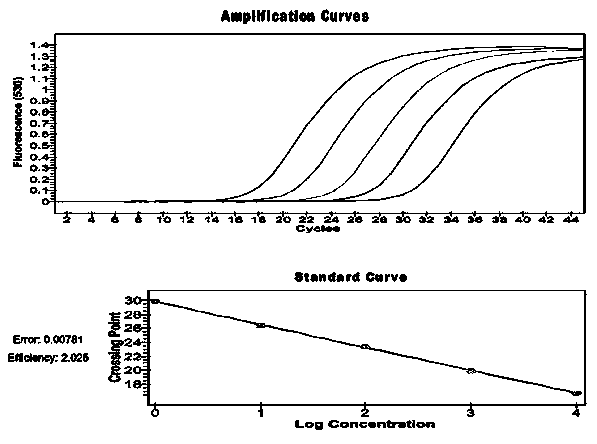Quantitative detection method and reagent kit of GSTP1 (Glutathione S-Transferase P1) methylation for predicting hepatic failure prognosis
A quantitative detection and methylation technology, applied in the determination/testing of microorganisms, biochemical equipment and methods, fluorescence/phosphorescence, etc., can solve the problems of dangerous diseases, poor prognosis, and high mortality
- Summary
- Abstract
- Description
- Claims
- Application Information
AI Technical Summary
Problems solved by technology
Method used
Image
Examples
Embodiment Construction
[0042] The main reagents in the GSTP1 gene methylation quantitative detection kit for predicting the prognosis of liver failure include: reagents for extracting genomic DNA from samples to be tested, reagents for modifying genomic DNA with bisulfite, 5× premixed PCR reaction system, standard products, positive Control, negative control, methylation-specific primer pair for the promoter of the target gene GSTP1 and a specific primer pair for the internal reference gene ALU-C4 and the corresponding Taqman fluorescent probe, the specific sequences are as follows:
[0043] GSTP1-upstream primer: 5'TTCGGGGTGTAGCGGTCGTC 3';
[0044] GSTP1-downstream primer: 5'GCCCCAATACTAAATCACGACG 3';
[0045] GSTP1-probe: 5'Fam AAATCCCGCGAACTCCCGCC 3'BHQ1;
[0046] ALU-C4-upstream primer: 5'GGTTAGGTATAGTGGTTTATATTTGTAATTTTAGTA 3';
[0047] ALU-C4-downstream primer: 5'ATTAACTAAACTAAATCTTAAACTCCTAACCTCA 3';
[0048] ALU-C4-probe: 5'Fam CCTACCTTAACCTCCC 3'BHQ1.
[0049] Among them, the reagents f...
PUM
 Login to View More
Login to View More Abstract
Description
Claims
Application Information
 Login to View More
Login to View More - R&D
- Intellectual Property
- Life Sciences
- Materials
- Tech Scout
- Unparalleled Data Quality
- Higher Quality Content
- 60% Fewer Hallucinations
Browse by: Latest US Patents, China's latest patents, Technical Efficacy Thesaurus, Application Domain, Technology Topic, Popular Technical Reports.
© 2025 PatSnap. All rights reserved.Legal|Privacy policy|Modern Slavery Act Transparency Statement|Sitemap|About US| Contact US: help@patsnap.com



